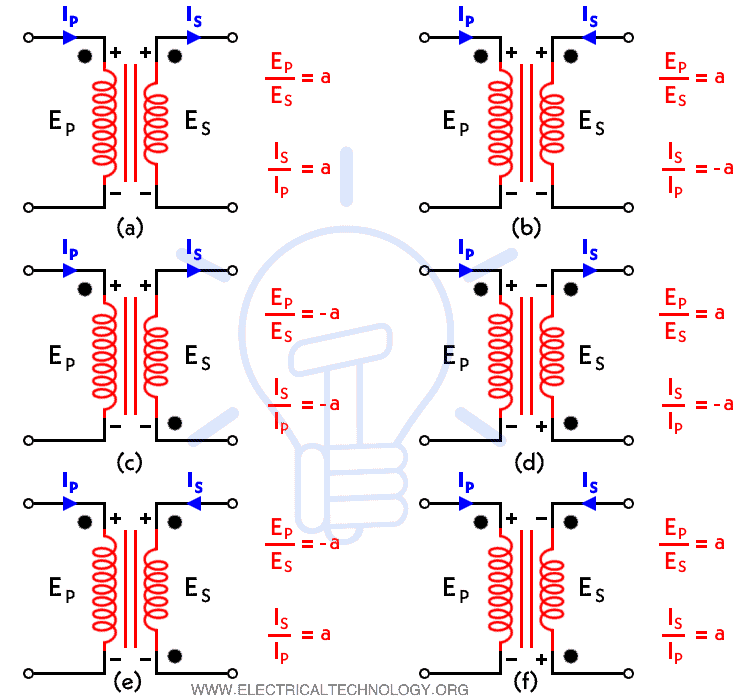The Dot Convention and Dot Notation in a Transformer Phasing
Transformer Phasing: The Dot Convention and Dot Notation for Transformer Polarity
The Dot Conversion (also known as the Dot Notation) is a polarity marking in a Transformer Phasing which is used to identify the phase relation between primary and secondary current and voltage in a transformer.
The manufacture and designer put a dot making or alpha numeric character on the both side of primary and secondary windings in a schematic circuit diagram. If both of the dots are on the upper side, it means, the voltage and current are in phase and the direction of primary current is same as the direction of secondary current.
In polarity test of a transformer, they put H1 and H2 or X1 & X1 marking instead of dot marking. It clearly shows that the H1 and H2 marking are used for primary (High Voltage) and H2 for secondary voltage. Same is the case for X1 and X2 making.
Related Posts:
- Open Circuit and Short Circuit Test of a Transformer
- Sumpner’s Test or Back-To-Back Test on Transformer
The Dot Notation
Generally, when we study transformers, we assume that the primary and secondary voltage and currents are in phase. But that is not always the case. In a transformer, the phase relation between primary and secondary currents and voltages depends on how each winding is wrapped around the core.
Refer to the fig (1) and (2), you may see that the primary sides of both transformers are identical i.e. primary windings of both transformers wrapped in the same direction around the core.
But in fig (2) you may notice that the secondary winding is wound around the core in the opposite direction from the secondary winding in fig (1).
Consequently, the voltage induced in the Secondary winding in fig (2) is 180° out of phase as compared with the induced voltage in secondary in fig (1) and the direction of secondary current (IS) is opposite from the primary current (IP) as well.
So we see that:
- The primary and secondary voltage and current are in phase in fig (1).
- The primary and secondary voltage and current are 180° out of phase in fig (2).
Related Post:
Dot Convention
The Dot Conversion as a polarity marking is used to identify both primary and secondary winding terminals of a transformer. Based on this, we may easily than connect the winding terminals of the transformers according to our needs.
To eliminate any confusion in the phase relation between primary and secondary voltage and current, a dot convention has been adopted for transformer schematic diagrams. Dots are placed on the top of primary and secondary terminals as shown in fig (3) and (4).
In fig (3), we see that dots are placed at the top in both primary and secondary terminals. It shows that the primary and secondary currents and voltages are in phase. Moreover, the primary and secondary voltages (VP and VS) have similar sine waves, also the primary and secondary (IP and IS) currents are the same in direction.
The story is opposite in fig (4). We can see that one dot is positioned at the top in the primary terminal and the other one (dot) is placed at the bottom of the secondary terminal. It shows that the primary and secondary currents and voltages are 180° out of phase. In addition, the primary and secondary voltages (VP and VS) sine waves are opposite to each other. Also the primary and secondary currents (IP and IS) are opposite in direction.
Now let’s what is the effect of the dot convention in a transformer as follow.
Suppose the NP and NS represents the primary and secondary turns where the turns ratio is a = NP ÷ NS
Turn Ratio = NP ÷ NS = a
Similarly, the EP and ES is the primary voltage and secondary induced voltage and IP and IS is the primary current and secondary respectively. The secondary induced voltage in the transformer assumed randomly for many cases as shown in the fig below.
This clearly shows the turn ratio and the direction of induced voltage and current for different scenarios based on the dot convention of the transformer. That’s why we connect the same dots points in an ideal transformer while referring circuit from one side to another.
Applications of Dot Convention
As transformers are not always in phase (as we assumed based on resistive load) e.g. the relation between voltage and current may be out of phase which depends on the core winding and its terminal directions.
Keep in mind that it may lead to serious damage to the power devices and equipment if we connect the wrong polarity of transformers as compared to the required system design. For this reason, we perform a polarity test (same like polarity of battery) on a transformer to identify the correct winding terminals in accordance. When identified correctly, the dot conventions are used for proper operation of the following systems.
- To eliminate the inverse polarity and phase loss
- Defeat protective relay operation and inaccurate energy and power measurement caused by reverse polarity of instrument transformers.
- Avoid negative power factor reading and measurement.
- Cancelation of signals and proper operation of amplifiers and speakers.
- To avoid the short circuit in the windings of parallel transformers.
For these reasons, manufacturers print a polarity indication which is a standard now known as the “Dot Convention” or “Dot Notation” on the transformer schematic as they are not transparent and the winding terminals and their direction can’t be seen by naked eye.
Related Posts:
- Why Transformer Rated In kVA, Not in KW?
- Applications of Transformers
- EMF Equation of a Transformer
- Equivalent Circuit of Electrical Transformer
- Transformer’s Losses- Types of Energy Losses in a Transformer
- What is the Transformer’s Voltage Regulation?
- Transformer Efficiency, All day Efficiency & Condition for Maximum Efficiency
- Transformer Performance & Electrical Parameters
- Power Transformer Protection and Faults
- Transformers Fire Protection System – Causes, Types & Requirements
- Advantages of Three Phase Transformer over Single Phase Transformer.
- Difference Between Power Transformers and Distribution Transformers?
- Can We Replace a 110/220 Turns Transformer with 10/20 Turns?
- Electrical Transformer Symbols – Single Line Transformer Symbols
- Can We Operate a 60Hz Transformer on 50Hz Supply Source and Vice Versa?
- Which Transformer is More Efficient When Operates on 50Hz or 60Hz?
- Transformers (MCQs With Explanatory Answers)











Very interesting topic and thanks for great posting. <br /><br /><a href="http://www.epsgroupaustralia.com.au" rel="nofollow">Commissioning Engineers </a><br />
why the transformer output is 180 degree out of phase in theoretical phenomena
this description of electrical system is very interesting page
How is the ‘dot’ indication used when you have a schematic like the Armstrong oscillator at this link:
https://en.wikipedia.org/wiki/Armstrong_oscillator
Since they are both at the top of the inductor coil, does that mean they are in phase? The explanation of the oscillator there leaves something to be desired…
Thanks
Jack Wilborn
KA7CMF
I have built a similar device as is described by this link:
http://ludens.cl/Electron/lmeter/lmeter.html
Makes it much easier to see the results. I use a atmega328p (@ 16Mhz) to drive the switch. I only use one pulse and trap it on my DSO. I bring this up, as I have a few baluns that I will try and catch the output of different windings.. Never thought of that before… Thanks for the information…
Funny, I looked at the entry I just posted and it has the times tamp as
10/20/2016 at 10:32 pm (copied and pasted)
It was actually at 10:32 am on 10/20/2016, unless this site is on the other side of the world..
Thanks
Jack
Now it all make sense, It was all about winding and in what direction, was never mentioned in any of my books. Now I understand the dot convention
Eesh… I don’t know anything about transformers. I have some learnin’ to do.
Good Day!
Many Thanks for such a helpful information regarding Dot notation of a Transformer in schematics.
I did never come across this for the last many many years.
Thanks Again.
All the Best.
Abdur Rab
Can you please clarify something? When I look at Fig 1 and Fig 2, I see absolutely no difference in how the right side of the transformer is wound (other than the arrows on the right side are reversed), so why then does the current reverse?
The current in the right side is generated by the magnetic field produced by the left side, so in effect, the left side is the “input” and the right is the “output”. Maybe in Fig 1 you wrapped from the bottom up, and in Fig 2, you wrapped from the top down, but the wire ends up looking exactly the same way. The wire doesn’t know the difference.
Now if you wrapped Fig 2 with the A wire behind the transformer, and the B wire in front of the transformer, then I could understand.
So what am I not understanding here?
Thank you!
Several of the secondaries above have dots at both the top and bottom of the winding? That makes no sense. Please clarify.
Thank you for clarification. We have modified the circuits and updated the images.